Business Development: Time Recording Module Project Report
VerifiedAdded on 2020/05/11
|18
|3157
|50
Project
AI Summary
This project report outlines the development of a Time Recording Module (TRM) for a company, aiming to replace a manual attendance system with an automated, card-based system. The report begins with a vision statement and proceeds to a Work Breakdown Structure (WBS), Gantt chart, and stakeholder analysis to define project scope, schedule, and involved parties. It analyzes the 'AS IS' manual attendance process and proposes a 'TO BE' automated system. The report includes a briefing note, screen designs, and acceptance criteria for the TRM. It also details the applications architecture, executive summary of the Request for Tender (RFT) report, and a comparison report. The project involves software and hardware procurement, system integration, customer acceptance, and data management. The RFT process, including vendor questions and answers, is thoroughly documented. The project aims to reduce errors, improve accuracy, and provide data for analysis, ultimately streamlining wage calculations and enhancing workforce management. References are included to support the analysis and methodologies applied.
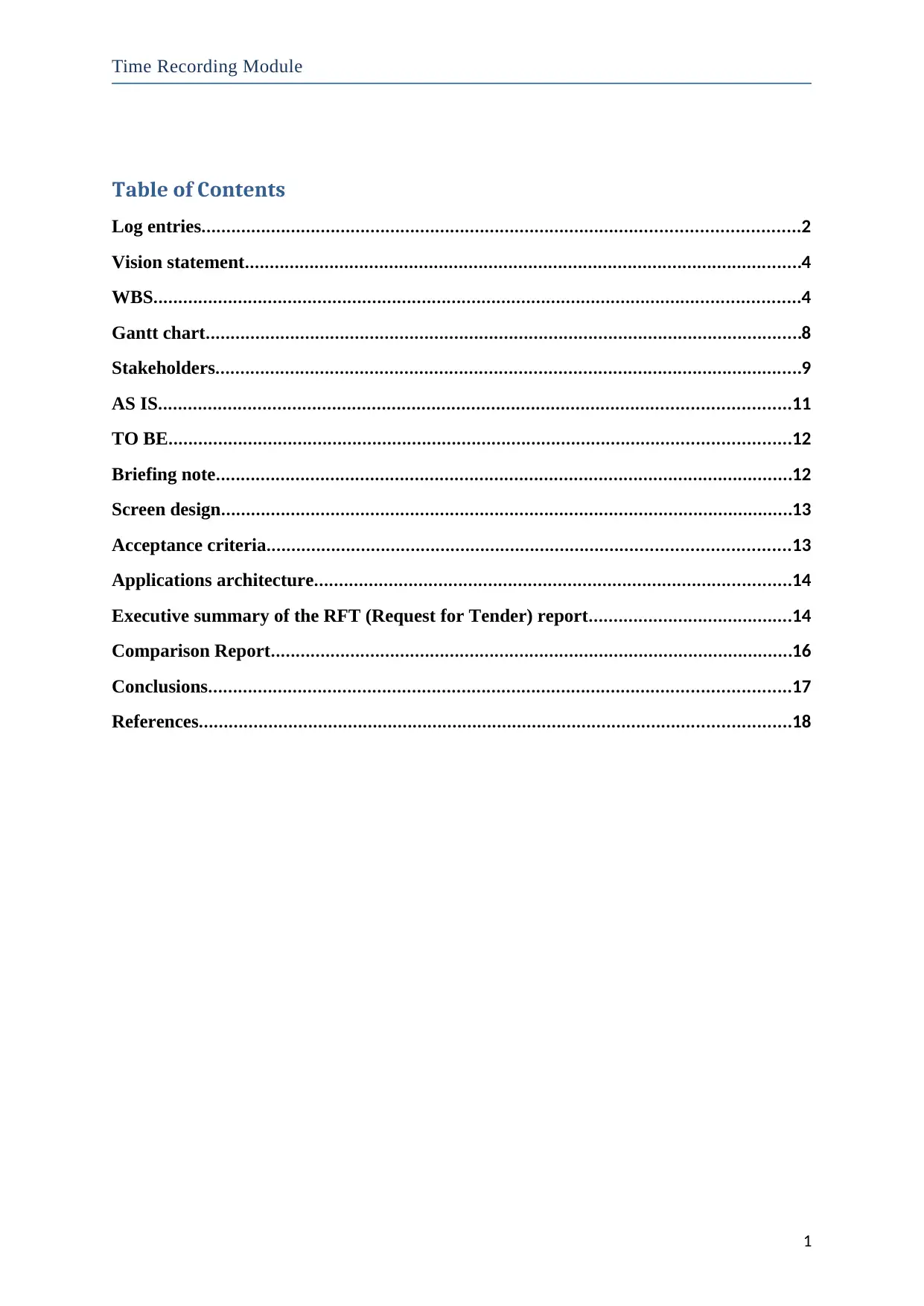
Time Recording Module
Table of Contents
Log entries........................................................................................................................2
Vision statement................................................................................................................4
WBS..................................................................................................................................4
Gantt chart........................................................................................................................8
Stakeholders......................................................................................................................9
AS IS...............................................................................................................................11
TO BE.............................................................................................................................12
Briefing note....................................................................................................................12
Screen design...................................................................................................................13
Acceptance criteria.........................................................................................................13
Applications architecture................................................................................................14
Executive summary of the RFT (Request for Tender) report.........................................14
Comparison Report.........................................................................................................16
Conclusions.....................................................................................................................17
References.......................................................................................................................18
1
Table of Contents
Log entries........................................................................................................................2
Vision statement................................................................................................................4
WBS..................................................................................................................................4
Gantt chart........................................................................................................................8
Stakeholders......................................................................................................................9
AS IS...............................................................................................................................11
TO BE.............................................................................................................................12
Briefing note....................................................................................................................12
Screen design...................................................................................................................13
Acceptance criteria.........................................................................................................13
Applications architecture................................................................................................14
Executive summary of the RFT (Request for Tender) report.........................................14
Comparison Report.........................................................................................................16
Conclusions.....................................................................................................................17
References.......................................................................................................................18
1
Paraphrase This Document
Need a fresh take? Get an instant paraphrase of this document with our AI Paraphraser
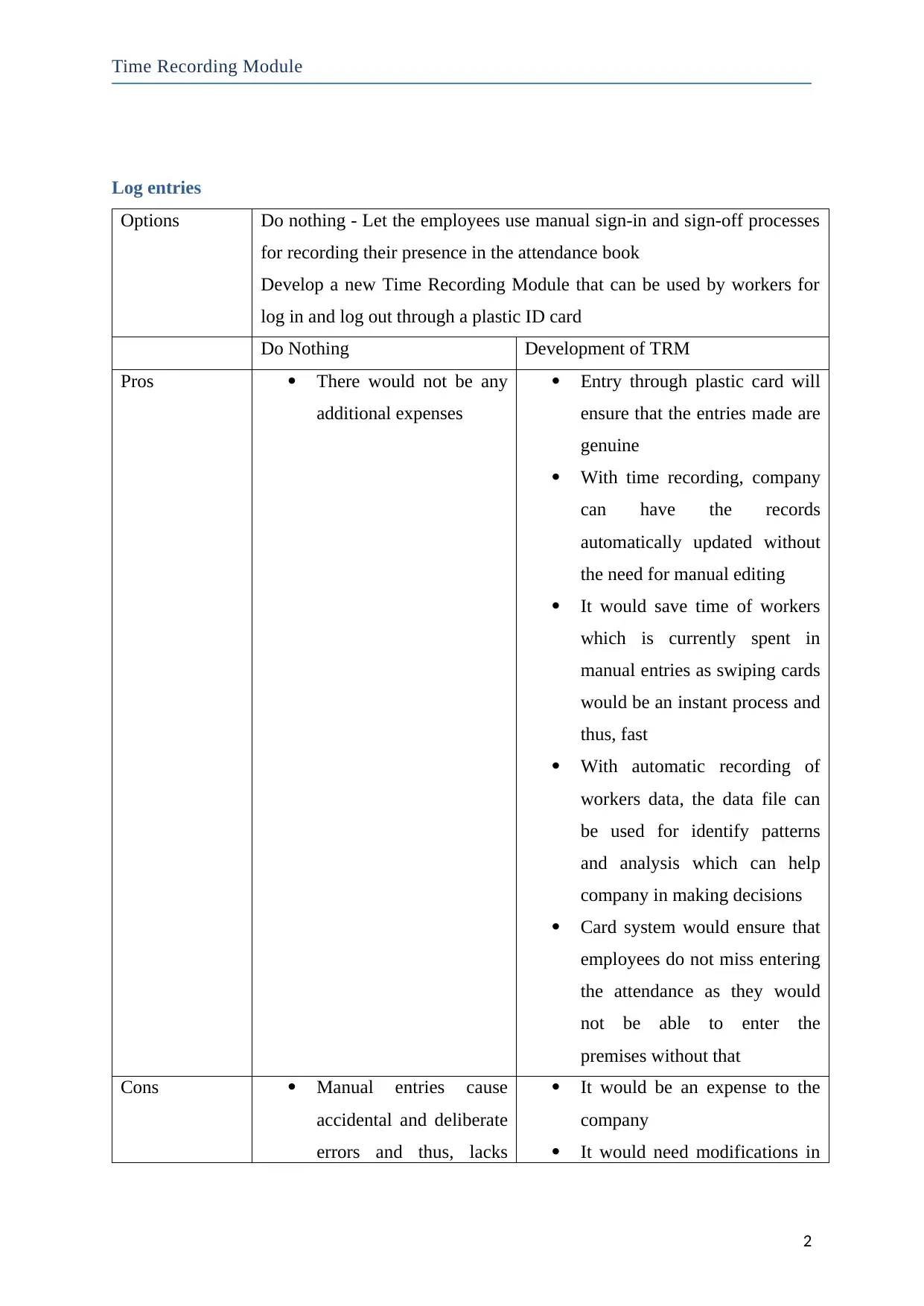
Time Recording Module
Log entries
Options Do nothing - Let the employees use manual sign-in and sign-off processes
for recording their presence in the attendance book
Develop a new Time Recording Module that can be used by workers for
log in and log out through a plastic ID card
Do Nothing Development of TRM
Pros There would not be any
additional expenses
Entry through plastic card will
ensure that the entries made are
genuine
With time recording, company
can have the records
automatically updated without
the need for manual editing
It would save time of workers
which is currently spent in
manual entries as swiping cards
would be an instant process and
thus, fast
With automatic recording of
workers data, the data file can
be used for identify patterns
and analysis which can help
company in making decisions
Card system would ensure that
employees do not miss entering
the attendance as they would
not be able to enter the
premises without that
Cons Manual entries cause
accidental and deliberate
errors and thus, lacks
It would be an expense to the
company
It would need modifications in
2
Log entries
Options Do nothing - Let the employees use manual sign-in and sign-off processes
for recording their presence in the attendance book
Develop a new Time Recording Module that can be used by workers for
log in and log out through a plastic ID card
Do Nothing Development of TRM
Pros There would not be any
additional expenses
Entry through plastic card will
ensure that the entries made are
genuine
With time recording, company
can have the records
automatically updated without
the need for manual editing
It would save time of workers
which is currently spent in
manual entries as swiping cards
would be an instant process and
thus, fast
With automatic recording of
workers data, the data file can
be used for identify patterns
and analysis which can help
company in making decisions
Card system would ensure that
employees do not miss entering
the attendance as they would
not be able to enter the
premises without that
Cons Manual entries cause
accidental and deliberate
errors and thus, lacks
It would be an expense to the
company
It would need modifications in
2
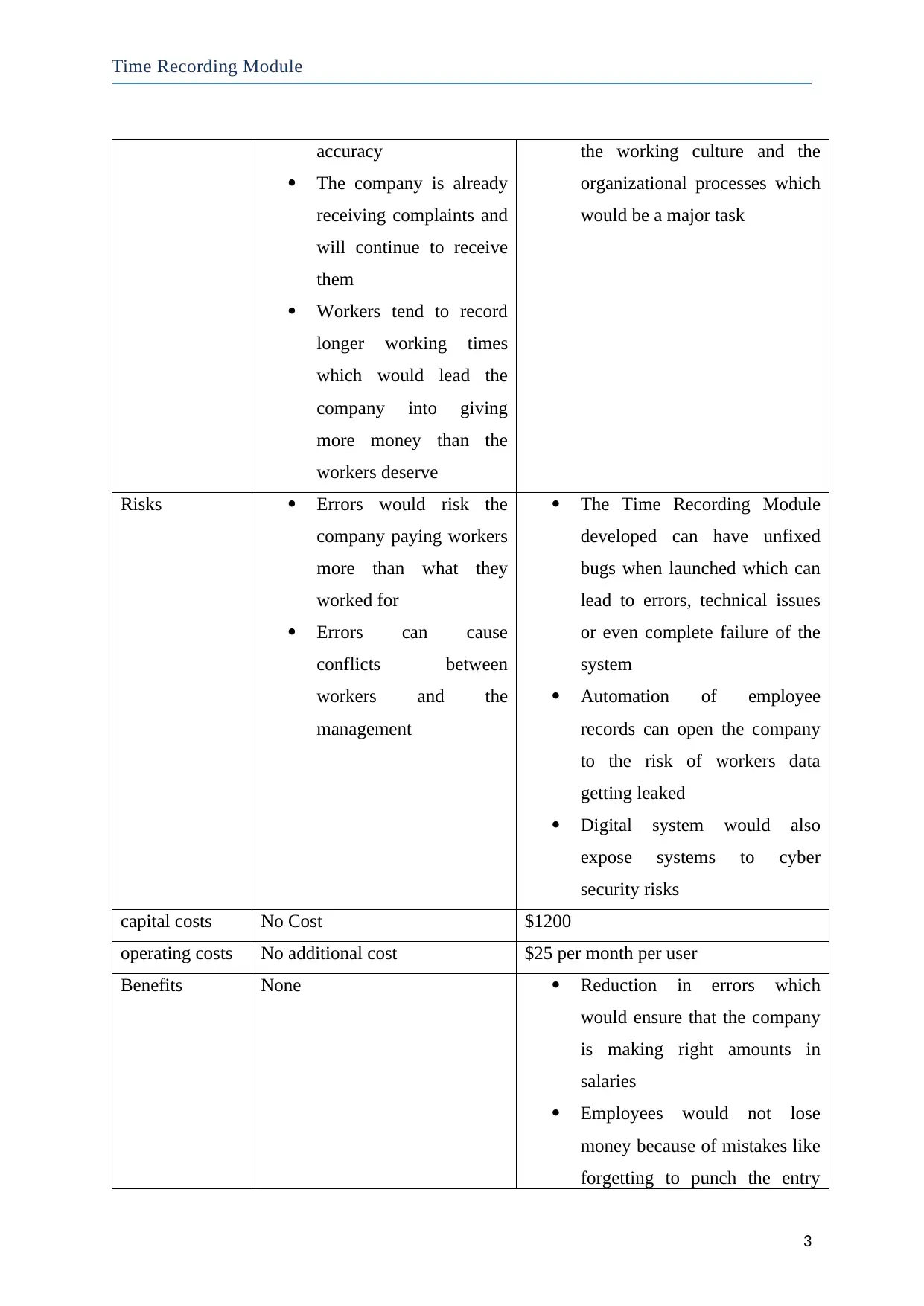
Time Recording Module
accuracy
The company is already
receiving complaints and
will continue to receive
them
Workers tend to record
longer working times
which would lead the
company into giving
more money than the
workers deserve
the working culture and the
organizational processes which
would be a major task
Risks Errors would risk the
company paying workers
more than what they
worked for
Errors can cause
conflicts between
workers and the
management
The Time Recording Module
developed can have unfixed
bugs when launched which can
lead to errors, technical issues
or even complete failure of the
system
Automation of employee
records can open the company
to the risk of workers data
getting leaked
Digital system would also
expose systems to cyber
security risks
capital costs No Cost $1200
operating costs No additional cost $25 per month per user
Benefits None Reduction in errors which
would ensure that the company
is making right amounts in
salaries
Employees would not lose
money because of mistakes like
forgetting to punch the entry
3
accuracy
The company is already
receiving complaints and
will continue to receive
them
Workers tend to record
longer working times
which would lead the
company into giving
more money than the
workers deserve
the working culture and the
organizational processes which
would be a major task
Risks Errors would risk the
company paying workers
more than what they
worked for
Errors can cause
conflicts between
workers and the
management
The Time Recording Module
developed can have unfixed
bugs when launched which can
lead to errors, technical issues
or even complete failure of the
system
Automation of employee
records can open the company
to the risk of workers data
getting leaked
Digital system would also
expose systems to cyber
security risks
capital costs No Cost $1200
operating costs No additional cost $25 per month per user
Benefits None Reduction in errors which
would ensure that the company
is making right amounts in
salaries
Employees would not lose
money because of mistakes like
forgetting to punch the entry
3
⊘ This is a preview!⊘
Do you want full access?
Subscribe today to unlock all pages.

Trusted by 1+ million students worldwide
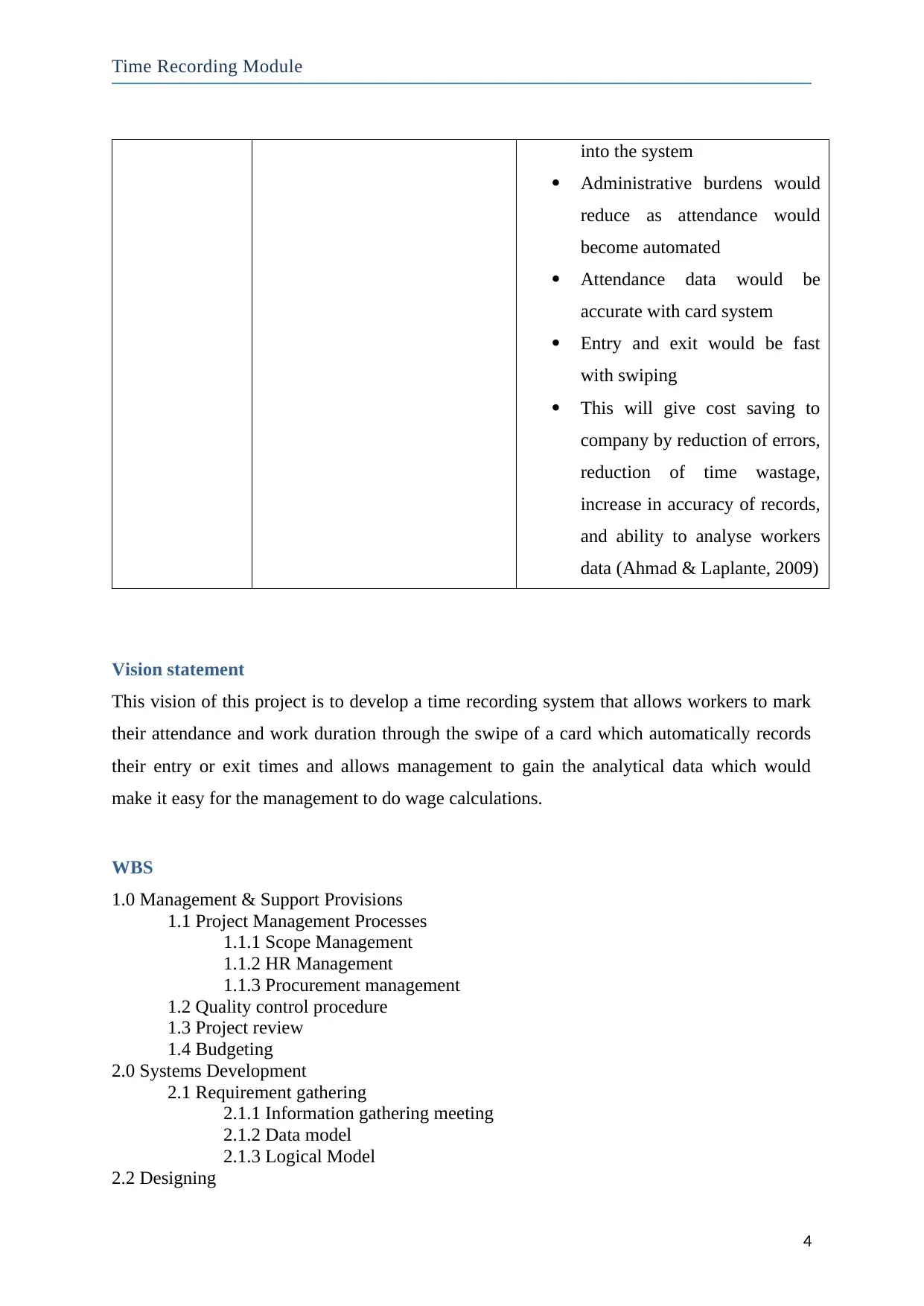
Time Recording Module
into the system
Administrative burdens would
reduce as attendance would
become automated
Attendance data would be
accurate with card system
Entry and exit would be fast
with swiping
This will give cost saving to
company by reduction of errors,
reduction of time wastage,
increase in accuracy of records,
and ability to analyse workers
data (Ahmad & Laplante, 2009)
Vision statement
This vision of this project is to develop a time recording system that allows workers to mark
their attendance and work duration through the swipe of a card which automatically records
their entry or exit times and allows management to gain the analytical data which would
make it easy for the management to do wage calculations.
WBS
1.0 Management & Support Provisions
1.1 Project Management Processes
1.1.1 Scope Management
1.1.2 HR Management
1.1.3 Procurement management
1.2 Quality control procedure
1.3 Project review
1.4 Budgeting
2.0 Systems Development
2.1 Requirement gathering
2.1.1 Information gathering meeting
2.1.2 Data model
2.1.3 Logical Model
2.2 Designing
4
into the system
Administrative burdens would
reduce as attendance would
become automated
Attendance data would be
accurate with card system
Entry and exit would be fast
with swiping
This will give cost saving to
company by reduction of errors,
reduction of time wastage,
increase in accuracy of records,
and ability to analyse workers
data (Ahmad & Laplante, 2009)
Vision statement
This vision of this project is to develop a time recording system that allows workers to mark
their attendance and work duration through the swipe of a card which automatically records
their entry or exit times and allows management to gain the analytical data which would
make it easy for the management to do wage calculations.
WBS
1.0 Management & Support Provisions
1.1 Project Management Processes
1.1.1 Scope Management
1.1.2 HR Management
1.1.3 Procurement management
1.2 Quality control procedure
1.3 Project review
1.4 Budgeting
2.0 Systems Development
2.1 Requirement gathering
2.1.1 Information gathering meeting
2.1.2 Data model
2.1.3 Logical Model
2.2 Designing
4
Paraphrase This Document
Need a fresh take? Get an instant paraphrase of this document with our AI Paraphraser
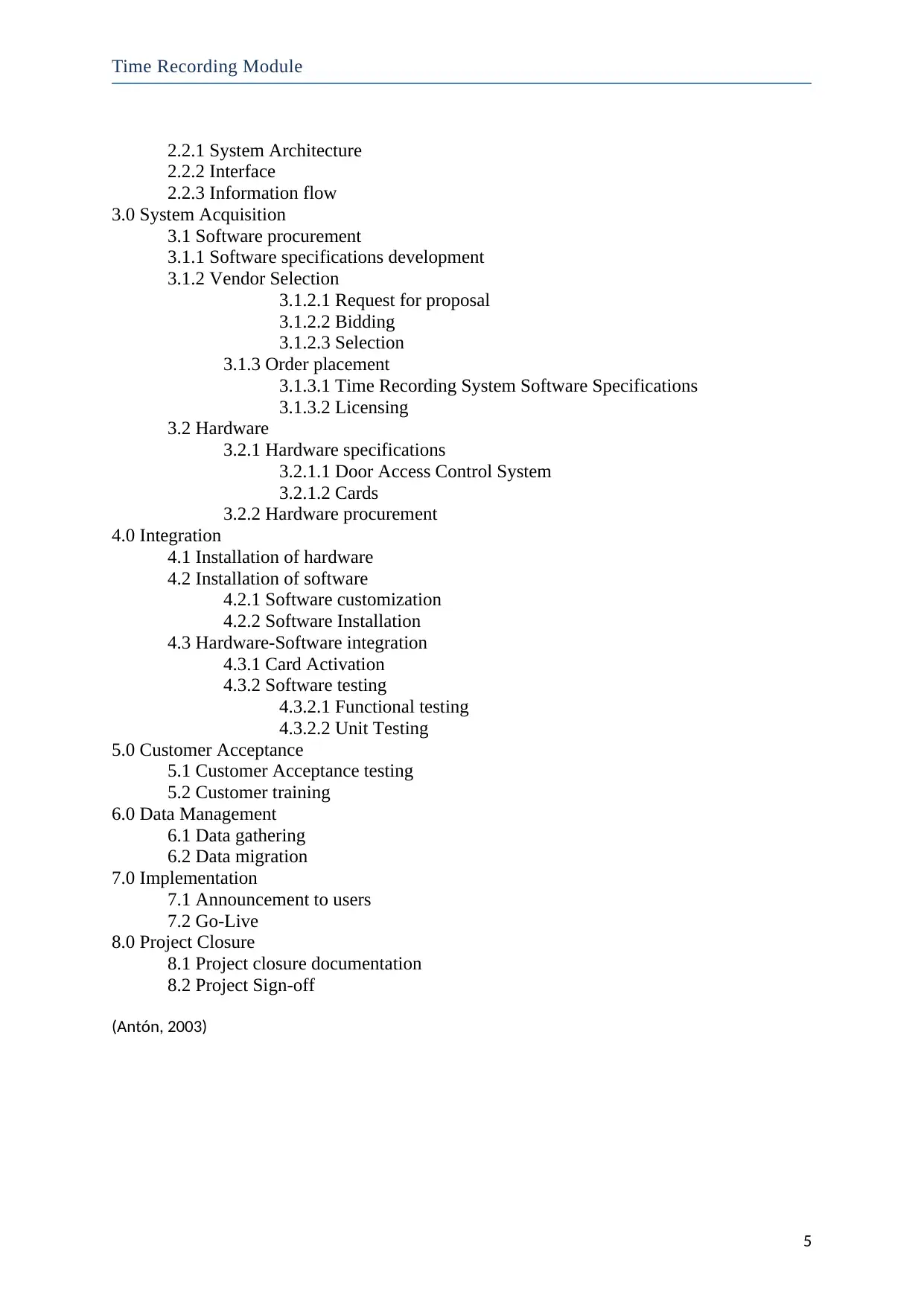
Time Recording Module
2.2.1 System Architecture
2.2.2 Interface
2.2.3 Information flow
3.0 System Acquisition
3.1 Software procurement
3.1.1 Software specifications development
3.1.2 Vendor Selection
3.1.2.1 Request for proposal
3.1.2.2 Bidding
3.1.2.3 Selection
3.1.3 Order placement
3.1.3.1 Time Recording System Software Specifications
3.1.3.2 Licensing
3.2 Hardware
3.2.1 Hardware specifications
3.2.1.1 Door Access Control System
3.2.1.2 Cards
3.2.2 Hardware procurement
4.0 Integration
4.1 Installation of hardware
4.2 Installation of software
4.2.1 Software customization
4.2.2 Software Installation
4.3 Hardware-Software integration
4.3.1 Card Activation
4.3.2 Software testing
4.3.2.1 Functional testing
4.3.2.2 Unit Testing
5.0 Customer Acceptance
5.1 Customer Acceptance testing
5.2 Customer training
6.0 Data Management
6.1 Data gathering
6.2 Data migration
7.0 Implementation
7.1 Announcement to users
7.2 Go-Live
8.0 Project Closure
8.1 Project closure documentation
8.2 Project Sign-off
(Antón, 2003)
5
2.2.1 System Architecture
2.2.2 Interface
2.2.3 Information flow
3.0 System Acquisition
3.1 Software procurement
3.1.1 Software specifications development
3.1.2 Vendor Selection
3.1.2.1 Request for proposal
3.1.2.2 Bidding
3.1.2.3 Selection
3.1.3 Order placement
3.1.3.1 Time Recording System Software Specifications
3.1.3.2 Licensing
3.2 Hardware
3.2.1 Hardware specifications
3.2.1.1 Door Access Control System
3.2.1.2 Cards
3.2.2 Hardware procurement
4.0 Integration
4.1 Installation of hardware
4.2 Installation of software
4.2.1 Software customization
4.2.2 Software Installation
4.3 Hardware-Software integration
4.3.1 Card Activation
4.3.2 Software testing
4.3.2.1 Functional testing
4.3.2.2 Unit Testing
5.0 Customer Acceptance
5.1 Customer Acceptance testing
5.2 Customer training
6.0 Data Management
6.1 Data gathering
6.2 Data migration
7.0 Implementation
7.1 Announcement to users
7.2 Go-Live
8.0 Project Closure
8.1 Project closure documentation
8.2 Project Sign-off
(Antón, 2003)
5
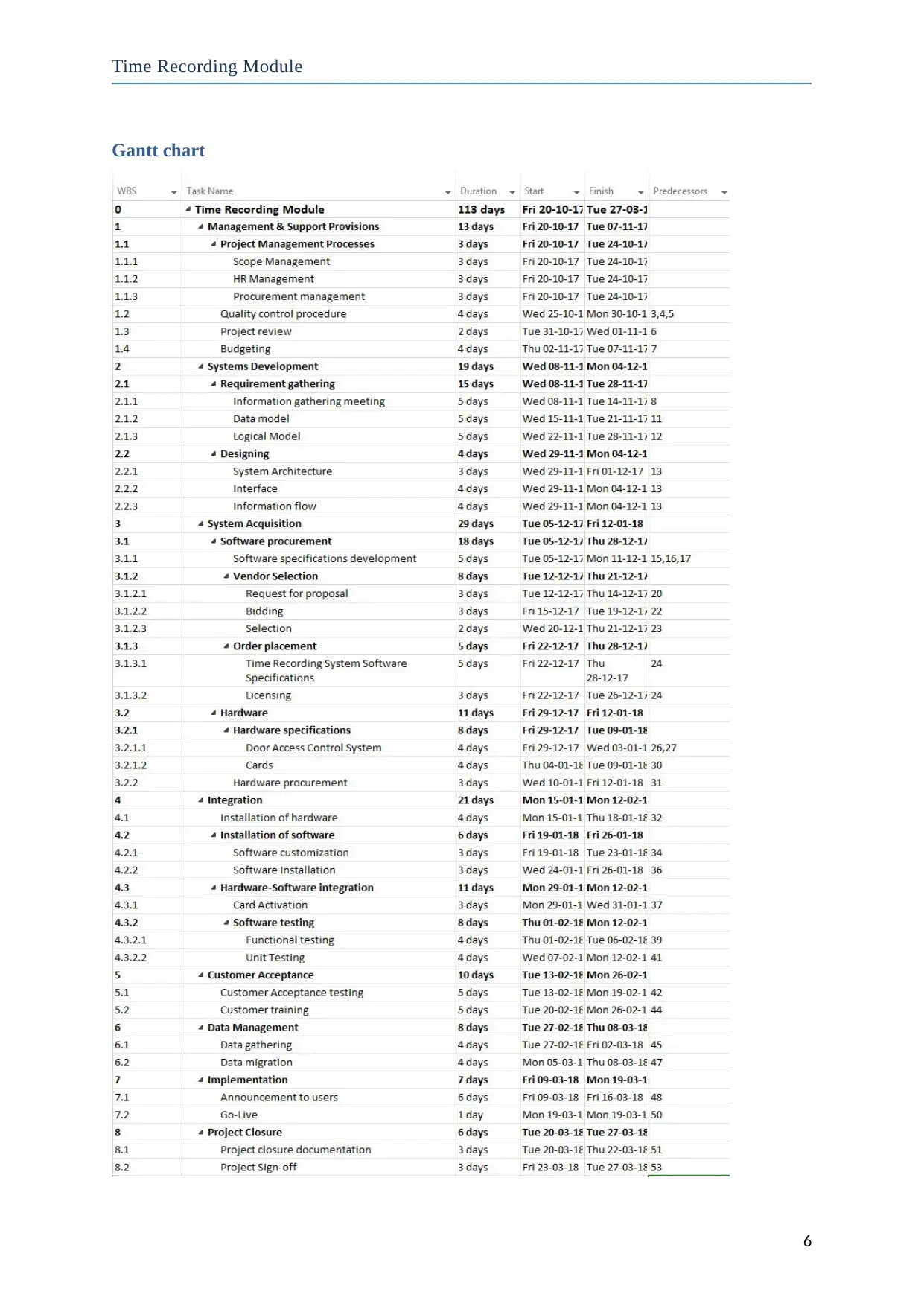
Time Recording Module
Gantt chart
6
Gantt chart
6
⊘ This is a preview!⊘
Do you want full access?
Subscribe today to unlock all pages.

Trusted by 1+ million students worldwide
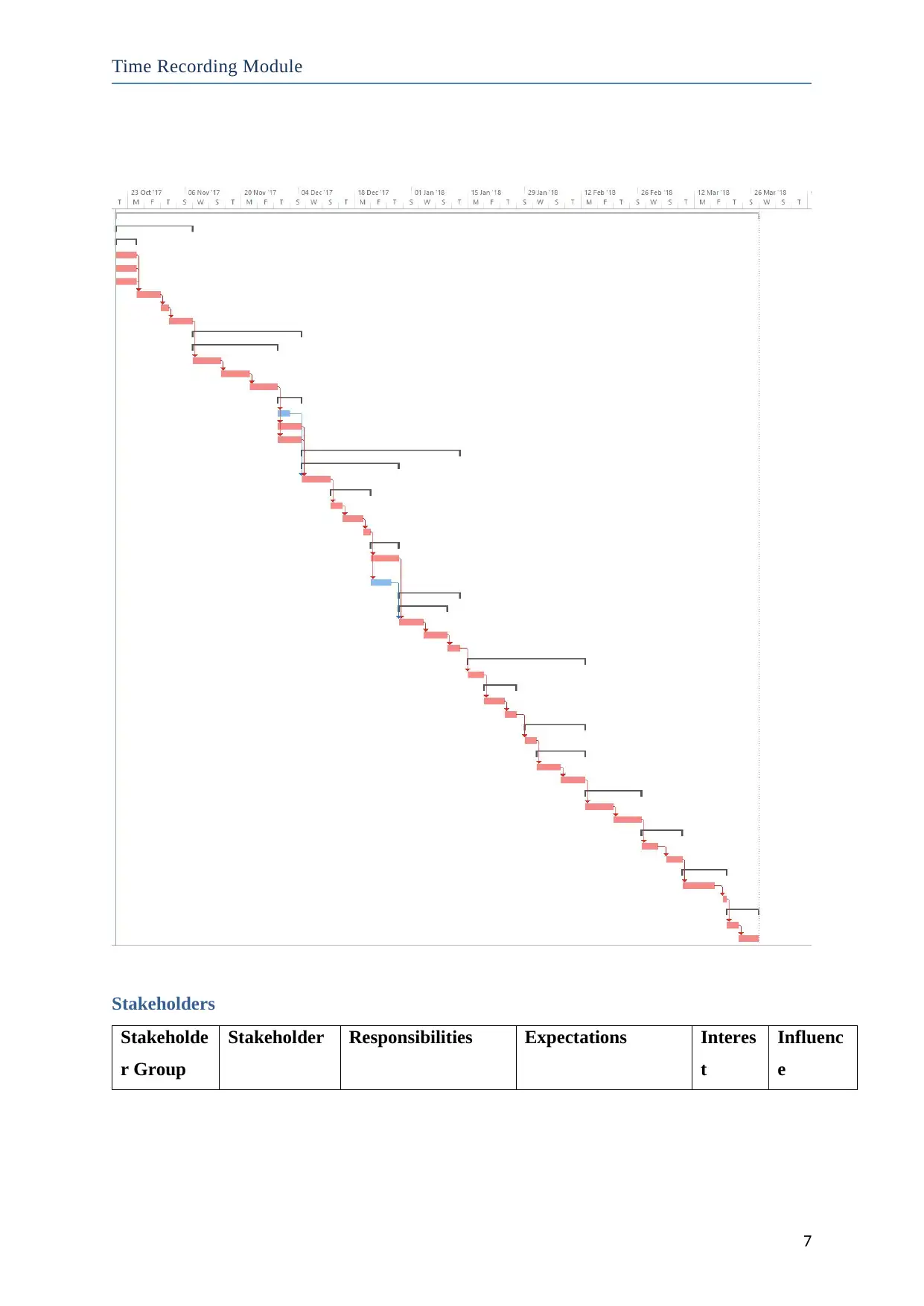
Time Recording Module
Stakeholders
Stakeholde
r Group
Stakeholder Responsibilities Expectations Interes
t
Influenc
e
7
Stakeholders
Stakeholde
r Group
Stakeholder Responsibilities Expectations Interes
t
Influenc
e
7
Paraphrase This Document
Need a fresh take? Get an instant paraphrase of this document with our AI Paraphraser
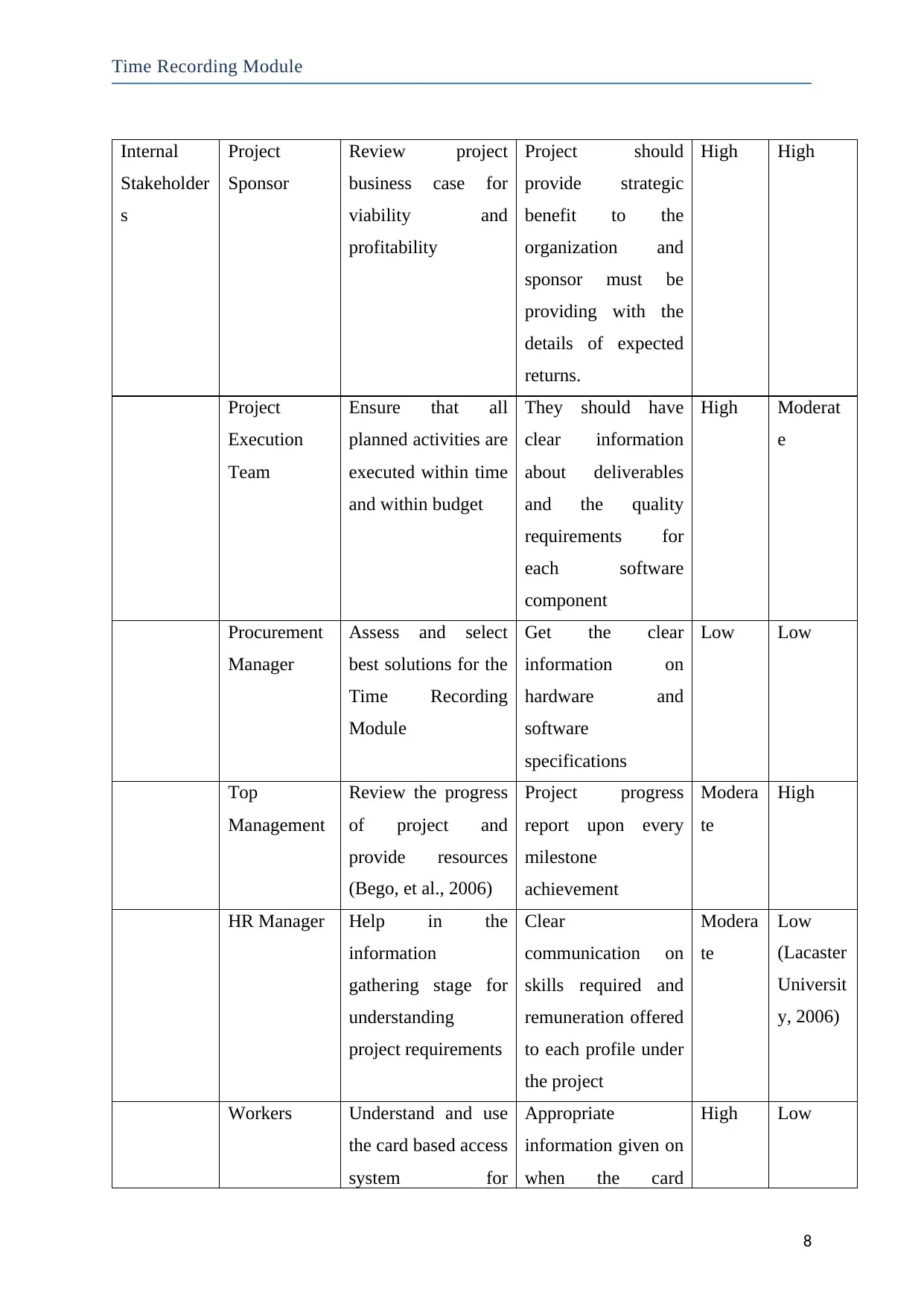
Time Recording Module
Internal
Stakeholder
s
Project
Sponsor
Review project
business case for
viability and
profitability
Project should
provide strategic
benefit to the
organization and
sponsor must be
providing with the
details of expected
returns.
High High
Project
Execution
Team
Ensure that all
planned activities are
executed within time
and within budget
They should have
clear information
about deliverables
and the quality
requirements for
each software
component
High Moderat
e
Procurement
Manager
Assess and select
best solutions for the
Time Recording
Module
Get the clear
information on
hardware and
software
specifications
Low Low
Top
Management
Review the progress
of project and
provide resources
(Bego, et al., 2006)
Project progress
report upon every
milestone
achievement
Modera
te
High
HR Manager Help in the
information
gathering stage for
understanding
project requirements
Clear
communication on
skills required and
remuneration offered
to each profile under
the project
Modera
te
Low
(Lacaster
Universit
y, 2006)
Workers Understand and use
the card based access
system for
Appropriate
information given on
when the card
High Low
8
Internal
Stakeholder
s
Project
Sponsor
Review project
business case for
viability and
profitability
Project should
provide strategic
benefit to the
organization and
sponsor must be
providing with the
details of expected
returns.
High High
Project
Execution
Team
Ensure that all
planned activities are
executed within time
and within budget
They should have
clear information
about deliverables
and the quality
requirements for
each software
component
High Moderat
e
Procurement
Manager
Assess and select
best solutions for the
Time Recording
Module
Get the clear
information on
hardware and
software
specifications
Low Low
Top
Management
Review the progress
of project and
provide resources
(Bego, et al., 2006)
Project progress
report upon every
milestone
achievement
Modera
te
High
HR Manager Help in the
information
gathering stage for
understanding
project requirements
Clear
communication on
skills required and
remuneration offered
to each profile under
the project
Modera
te
Low
(Lacaster
Universit
y, 2006)
Workers Understand and use
the card based access
system for
Appropriate
information given on
when the card
High Low
8
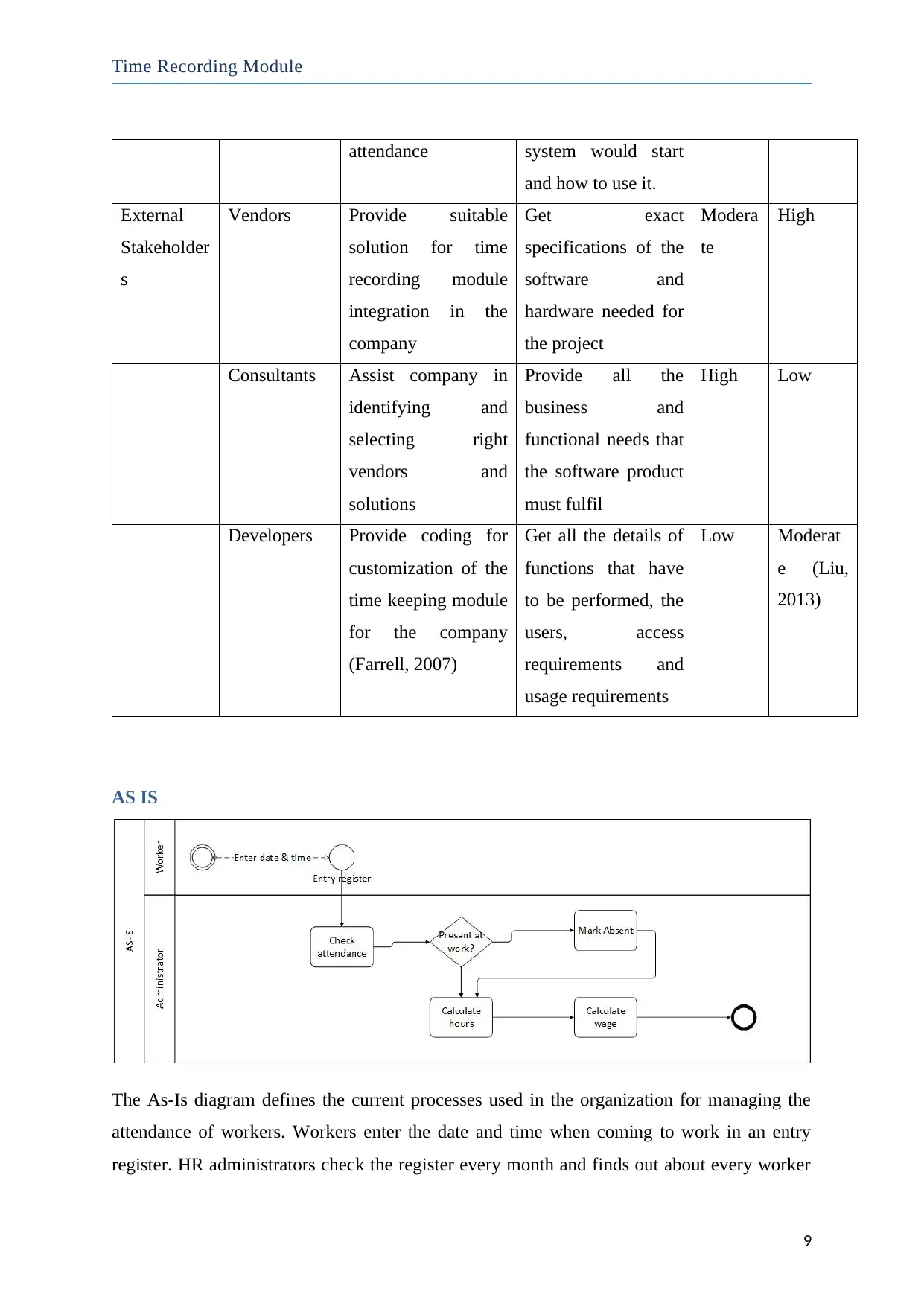
Time Recording Module
attendance system would start
and how to use it.
External
Stakeholder
s
Vendors Provide suitable
solution for time
recording module
integration in the
company
Get exact
specifications of the
software and
hardware needed for
the project
Modera
te
High
Consultants Assist company in
identifying and
selecting right
vendors and
solutions
Provide all the
business and
functional needs that
the software product
must fulfil
High Low
Developers Provide coding for
customization of the
time keeping module
for the company
(Farrell, 2007)
Get all the details of
functions that have
to be performed, the
users, access
requirements and
usage requirements
Low Moderat
e (Liu,
2013)
AS IS
The As-Is diagram defines the current processes used in the organization for managing the
attendance of workers. Workers enter the date and time when coming to work in an entry
register. HR administrators check the register every month and finds out about every worker
9
attendance system would start
and how to use it.
External
Stakeholder
s
Vendors Provide suitable
solution for time
recording module
integration in the
company
Get exact
specifications of the
software and
hardware needed for
the project
Modera
te
High
Consultants Assist company in
identifying and
selecting right
vendors and
solutions
Provide all the
business and
functional needs that
the software product
must fulfil
High Low
Developers Provide coding for
customization of the
time keeping module
for the company
(Farrell, 2007)
Get all the details of
functions that have
to be performed, the
users, access
requirements and
usage requirements
Low Moderat
e (Liu,
2013)
AS IS
The As-Is diagram defines the current processes used in the organization for managing the
attendance of workers. Workers enter the date and time when coming to work in an entry
register. HR administrators check the register every month and finds out about every worker
9
⊘ This is a preview!⊘
Do you want full access?
Subscribe today to unlock all pages.

Trusted by 1+ million students worldwide
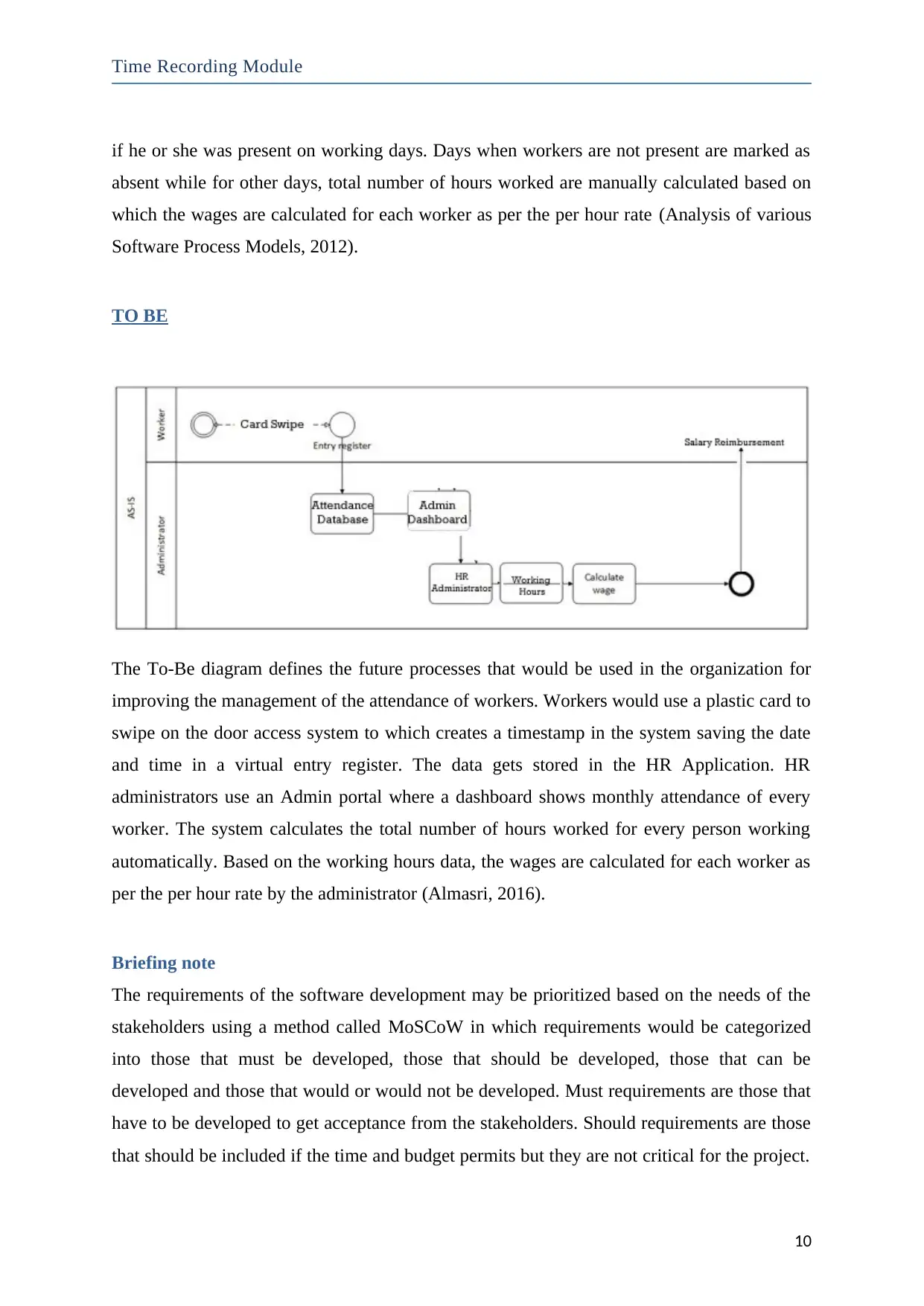
Time Recording Module
if he or she was present on working days. Days when workers are not present are marked as
absent while for other days, total number of hours worked are manually calculated based on
which the wages are calculated for each worker as per the per hour rate (Analysis of various
Software Process Models, 2012).
TO BE
The To-Be diagram defines the future processes that would be used in the organization for
improving the management of the attendance of workers. Workers would use a plastic card to
swipe on the door access system to which creates a timestamp in the system saving the date
and time in a virtual entry register. The data gets stored in the HR Application. HR
administrators use an Admin portal where a dashboard shows monthly attendance of every
worker. The system calculates the total number of hours worked for every person working
automatically. Based on the working hours data, the wages are calculated for each worker as
per the per hour rate by the administrator (Almasri, 2016).
Briefing note
The requirements of the software development may be prioritized based on the needs of the
stakeholders using a method called MoSCoW in which requirements would be categorized
into those that must be developed, those that should be developed, those that can be
developed and those that would or would not be developed. Must requirements are those that
have to be developed to get acceptance from the stakeholders. Should requirements are those
that should be included if the time and budget permits but they are not critical for the project.
10
if he or she was present on working days. Days when workers are not present are marked as
absent while for other days, total number of hours worked are manually calculated based on
which the wages are calculated for each worker as per the per hour rate (Analysis of various
Software Process Models, 2012).
TO BE
The To-Be diagram defines the future processes that would be used in the organization for
improving the management of the attendance of workers. Workers would use a plastic card to
swipe on the door access system to which creates a timestamp in the system saving the date
and time in a virtual entry register. The data gets stored in the HR Application. HR
administrators use an Admin portal where a dashboard shows monthly attendance of every
worker. The system calculates the total number of hours worked for every person working
automatically. Based on the working hours data, the wages are calculated for each worker as
per the per hour rate by the administrator (Almasri, 2016).
Briefing note
The requirements of the software development may be prioritized based on the needs of the
stakeholders using a method called MoSCoW in which requirements would be categorized
into those that must be developed, those that should be developed, those that can be
developed and those that would or would not be developed. Must requirements are those that
have to be developed to get acceptance from the stakeholders. Should requirements are those
that should be included if the time and budget permits but they are not critical for the project.
10
Paraphrase This Document
Need a fresh take? Get an instant paraphrase of this document with our AI Paraphraser
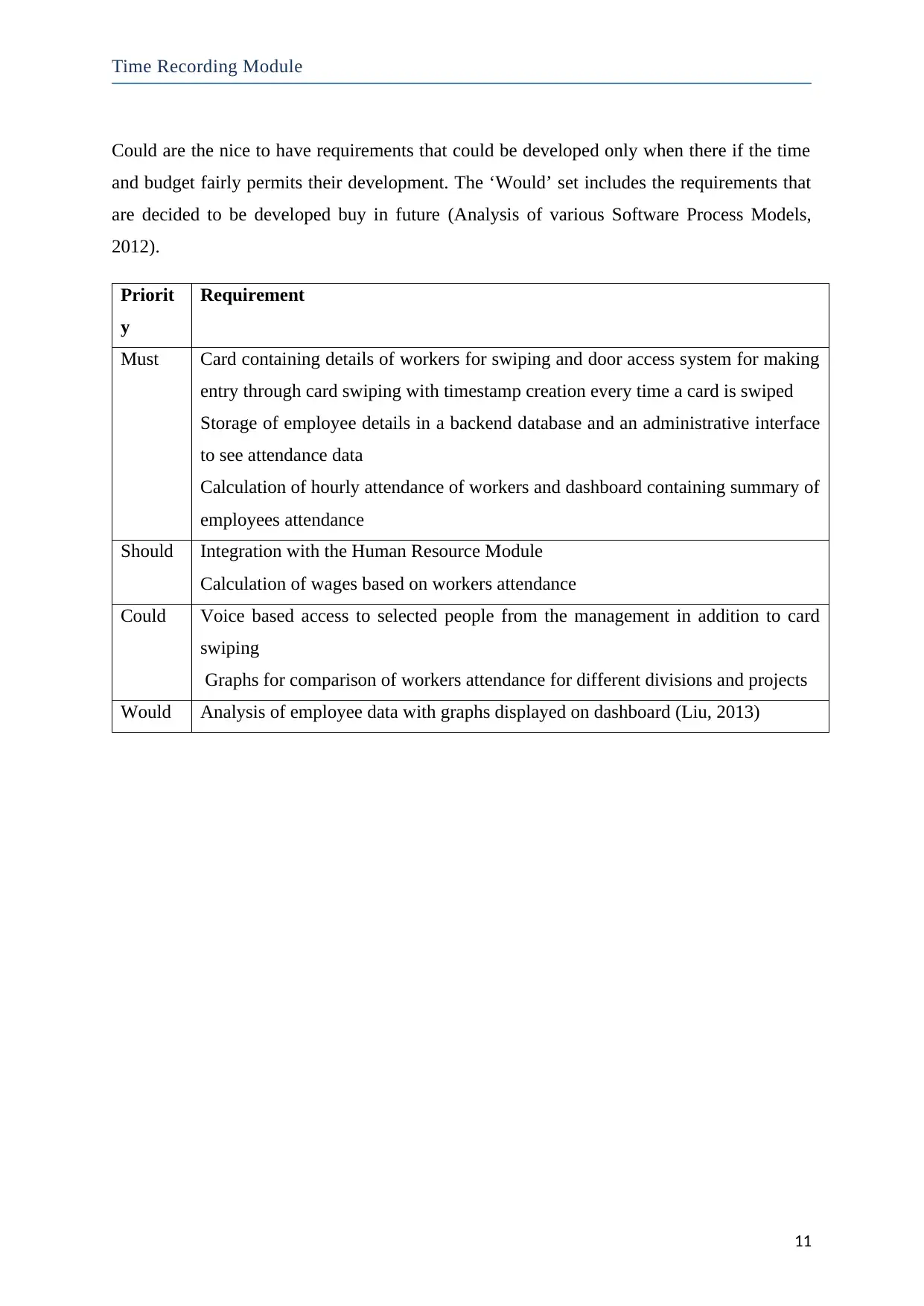
Time Recording Module
Could are the nice to have requirements that could be developed only when there if the time
and budget fairly permits their development. The ‘Would’ set includes the requirements that
are decided to be developed buy in future (Analysis of various Software Process Models,
2012).
Priorit
y
Requirement
Must Card containing details of workers for swiping and door access system for making
entry through card swiping with timestamp creation every time a card is swiped
Storage of employee details in a backend database and an administrative interface
to see attendance data
Calculation of hourly attendance of workers and dashboard containing summary of
employees attendance
Should Integration with the Human Resource Module
Calculation of wages based on workers attendance
Could Voice based access to selected people from the management in addition to card
swiping
Graphs for comparison of workers attendance for different divisions and projects
Would Analysis of employee data with graphs displayed on dashboard (Liu, 2013)
11
Could are the nice to have requirements that could be developed only when there if the time
and budget fairly permits their development. The ‘Would’ set includes the requirements that
are decided to be developed buy in future (Analysis of various Software Process Models,
2012).
Priorit
y
Requirement
Must Card containing details of workers for swiping and door access system for making
entry through card swiping with timestamp creation every time a card is swiped
Storage of employee details in a backend database and an administrative interface
to see attendance data
Calculation of hourly attendance of workers and dashboard containing summary of
employees attendance
Should Integration with the Human Resource Module
Calculation of wages based on workers attendance
Could Voice based access to selected people from the management in addition to card
swiping
Graphs for comparison of workers attendance for different divisions and projects
Would Analysis of employee data with graphs displayed on dashboard (Liu, 2013)
11
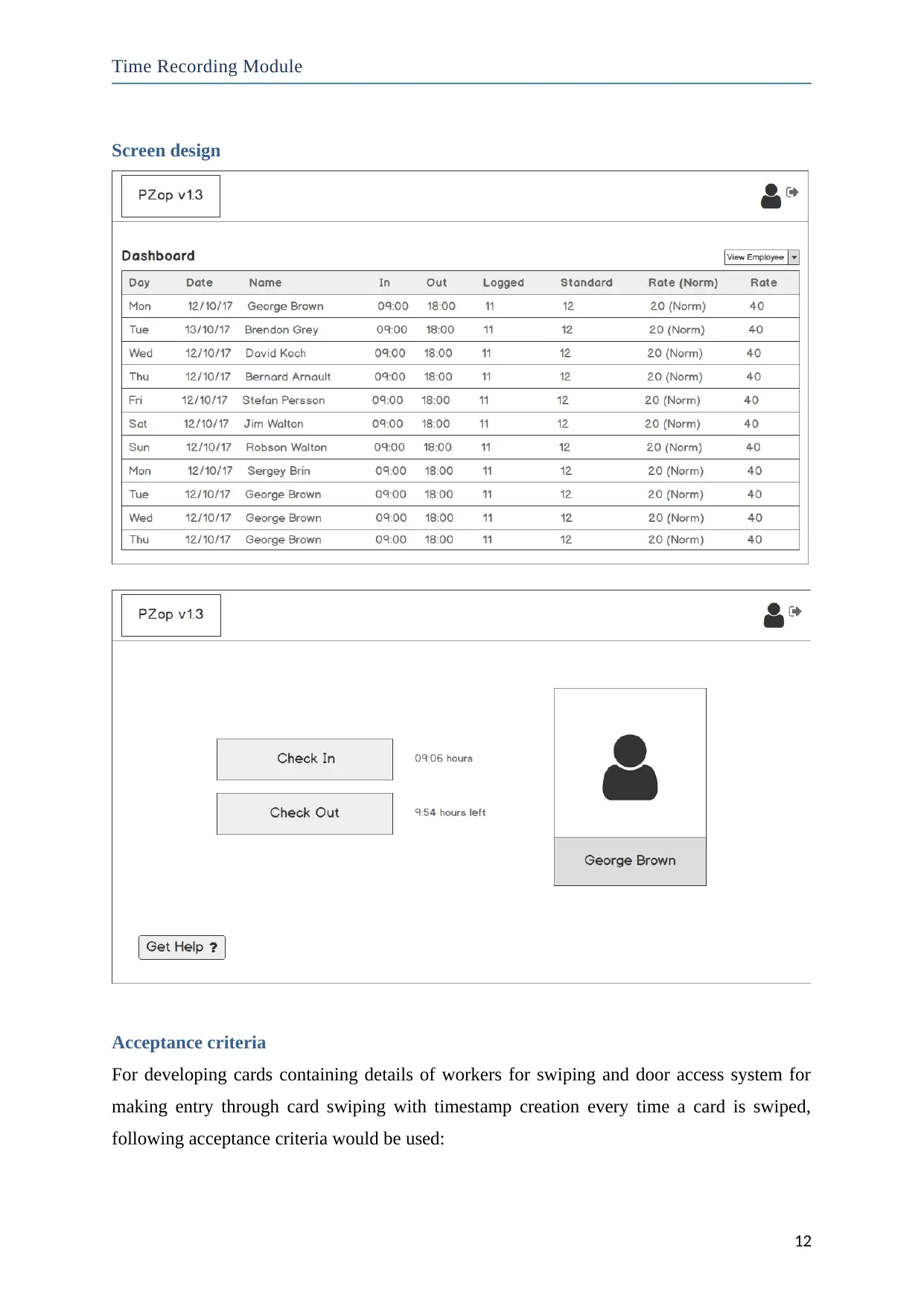
Time Recording Module
Screen design
Acceptance criteria
For developing cards containing details of workers for swiping and door access system for
making entry through card swiping with timestamp creation every time a card is swiped,
following acceptance criteria would be used:
12
Screen design
Acceptance criteria
For developing cards containing details of workers for swiping and door access system for
making entry through card swiping with timestamp creation every time a card is swiped,
following acceptance criteria would be used:
12
⊘ This is a preview!⊘
Do you want full access?
Subscribe today to unlock all pages.

Trusted by 1+ million students worldwide
1 out of 18
Related Documents
Your All-in-One AI-Powered Toolkit for Academic Success.
+13062052269
info@desklib.com
Available 24*7 on WhatsApp / Email
![[object Object]](/_next/static/media/star-bottom.7253800d.svg)
Unlock your academic potential
Copyright © 2020–2025 A2Z Services. All Rights Reserved. Developed and managed by ZUCOL.





